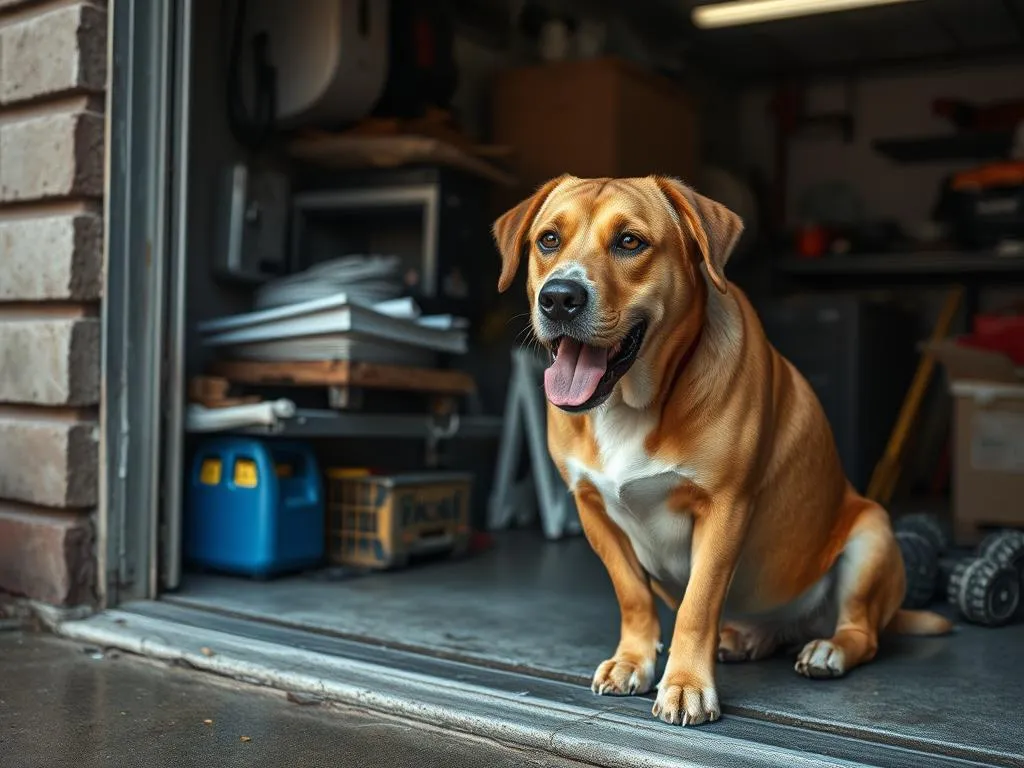
Understanding your dog’s health care needs is crucial for their overall well-being. One common question that arises among dog owners is, can you leave a dog in the garage while at work? This article delves into the implications of leaving dogs in garages during work hours, focusing on key considerations such as temperature, safety, and mental stimulation.
Understanding Your Dog’s Needs
Physical Needs
Dogs, like humans, require regular exercise to maintain their physical health. Depending on the breed and age, exercise needs can vary significantly. For instance, active breeds such as Border Collies may need more than two hours of exercise daily, while smaller breeds might be satisfied with shorter walks.
Furthermore, all dogs need regular bathroom breaks. Leaving a dog in a garage for extended periods without access to an appropriate bathroom area can lead to accidents and stress. Additionally, it is essential to ensure that your dog has access to fresh water and food, especially if you’ll be gone for several hours.
Emotional and Mental Needs
Dogs are social animals that thrive on companionship. Prolonged isolation can lead to anxiety and behavioral issues. To counter this, you should ensure that your dog has adequate socialization opportunities, whether through interactions with family members or playdates with other dogs.
Mental stimulation is equally important. Providing toys, puzzles, and interactive games can help keep your dog engaged while you’re away. Boredom can lead to destructive behavior, which is another reason why leaving a dog in the garage for long hours can be problematic.
Environmental Needs
The garage environment must meet your dog’s safety and comfort requirements. A safe space should be free from hazards such as sharp tools, chemicals, and heavy equipment that could cause injury. Additionally, consider the garage’s temperature; extreme heat or cold can be harmful. Dogs need a comfortable, clean area with enough room to move around and relax.
The Garage Environment
Safety Considerations
Garages often contain various hazards that can pose risks to your dog. Tools, chemicals, and sharp objects can lead to accidents if not secured properly. It’s vital to dog-proof the garage by removing or locking away any potentially dangerous items.
Additionally, be aware of heavy equipment and machinery that could inadvertently harm your dog. Creating a designated space within the garage that is free of hazards can help ensure your dog’s safety while you’re away.
Temperature Control
Extreme temperatures are one of the most significant risks associated with leaving a dog in the garage. In hot weather, garages can quickly become ovens, leading to heatstroke, while in cold weather, they can be frigid and lead to hypothermia.
To maintain a comfortable environment, consider the following best practices:
– Ensure proper ventilation to allow for air circulation.
– Use fans in warmer weather to keep the air cool.
– In colder months, provide warm bedding and consider the use of a space heater (with caution).
Signs of temperature distress in dogs include excessive panting, drooling, lethargy, or restlessness. It’s essential to monitor these signs closely if you must leave your dog in the garage.
Space and Comfort
Evaluate the size of your garage to determine if it’s suitable for your dog. Larger breeds may require more space to move around comfortably. Providing a comfortable resting area with bedding and blankets can help your dog feel more at ease. Ensuring adequate ventilation is also crucial to maintain a pleasant atmosphere.
Duration and Frequency
Ideal Duration for Leaving a Dog Alone
Understanding how long you can leave your dog alone is vital for their well-being. Generally, adult dogs should not be left alone for more than 4 to 6 hours at a time. Puppies and senior dogs may require more frequent breaks due to their physical needs.
The ideal duration can also depend on the dog’s age, breed, and temperament. For example, a high-energy dog may become anxious and destructive if left alone for extended periods. Be mindful of your dog’s individual needs and adjust your routine accordingly.
Frequency of Leaving a Dog in the Garage
The frequency of leaving your dog in the garage should also be considered. Daily routines can be more challenging for dogs who thrive on companionship. Occasionally using the garage is less likely to cause distress compared to making it a regular habit.
Training your dog to be comfortable with brief periods of separation can help. Gradually acclimatizing them to being in the garage for short intervals can build their confidence and reduce anxiety.
Alternatives to Leaving a Dog in the Garage
Dog Daycare Options
If you find it challenging to leave your dog in the garage during work hours, consider enrolling them in a dog daycare. Professional care provides socialization and stimulation throughout the day. When selecting a daycare, consider the following:
– Look for facilities with positive reviews and happy dogs.
– Ensure they offer plenty of outdoor playtime.
– Visit the facility to observe the environment and staff interactions.
Hiring a Dog Walker or Pet Sitter
Hiring a dog walker or pet sitter can provide companionship and care during work hours. This option allows your dog to enjoy some exercise and social interaction while you’re at work. When looking for a reliable professional, ask for recommendations and check references to ensure your dog’s safety and well-being.
Dog-Proofing the House
Creating a safe space in your home for your dog while you’re away can reduce the need for garage confinement. Consider dog-proofing a specific area by removing potential hazards and providing them with toys and comfortable bedding. This option allows your dog to enjoy the comforts of home instead of being isolated in the garage.
Signs of Distress in Dogs
Behavioral Signals
Observing your dog’s behavior can provide insights into their emotional state. Common signs of anxiety or discomfort include excessive barking, whining, pacing, or destructiveness. When you return home, take note of how your dog behaves; they may greet you with excitement or display signs of distress, which can indicate that they did not fare well in your absence.
Physical Symptoms
In addition to behavioral signals, physical symptoms can indicate distress. Look for excessive drooling, panting, or signs of lethargy. If your dog exhibits any concerning behaviors, it’s essential to consult with a veterinarian to rule out any underlying health issues.
Conclusion
In summary, while the question of can you leave a dog in the garage while at work? is complex, it ultimately hinges on understanding your dog’s individual needs. Consider their physical, emotional, and environmental requirements. Always prioritize safety and comfort, and if leaving them in the garage poses risks, explore alternatives such as dog daycare or professional pet services.
As a responsible dog owner, it’s essential to assess your dog’s unique circumstances and ensure their health and happiness while you are away.
FAQs
Can I leave my dog in the garage overnight?
Leaving a dog in the garage overnight is not recommended due to potential safety hazards and temperature fluctuations. Dogs need regular access to outdoor spaces for bathroom breaks and exercise.
What temperature is too hot/cold for a dog in a garage?
Generally, temperatures above 85°F (29°C) can pose heatstroke risks, while temperatures below 32°F (0°C) can be dangerous for dogs, especially small or short-haired breeds. Always monitor the garage environment closely.
How can I keep my dog entertained while I’m at work?
Providing interactive toys, puzzle feeders, and rotating toys can keep your dog engaged while you’re away. Consider leaving a radio or TV on to provide auditory stimulation.
What should I do if my dog shows signs of distress?
If your dog exhibits signs of distress, consult with a veterinarian for advice and consider alternative care options. Observing your dog’s behavior closely can help determine the best course of action.









